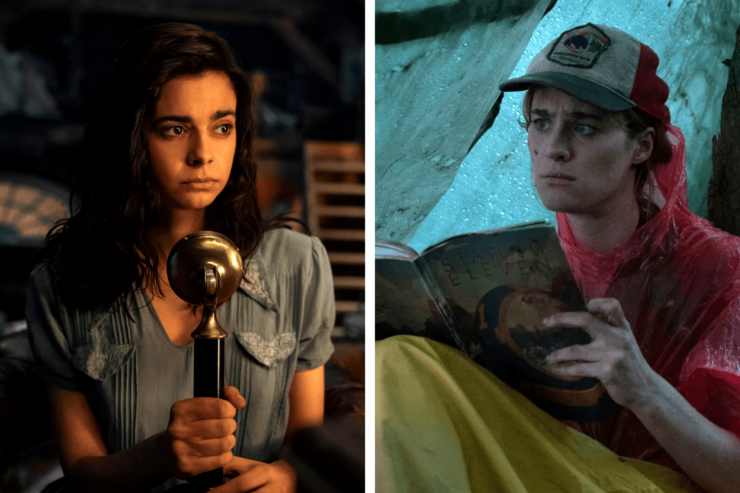I was sitting on my couch in my Brooklyn basement apartment a couple months ago, experiencing a strange sense of déjà vu. I was watching Netflix’s new miniseries All the Light We Cannot See starring Mark Ruffalo, Aria Mia Loberti, and Hugh Laurie, and another show kept haunting the back of my mind: I kept thinking about HBO Max’s Station Eleven, from 2021.
At first, I couldn’t figure out why the two reminded me of each other—All the Light is historical fiction and Station Eleven is sci-fi dystopia. Both are adaptations of hugely popular books (by Anthony Doerr and Emily St. John Mandel, respectively) but that’s not unique. The more I thought about the books, however, the more I noticed the similarities. Both came out in 2014, both were National Book Award finalists, and both follow a cast of characters over multiple decades and POVs. Still, there are plenty of books that would fit all of these criteria.
Then I had an epiphany… I realized the crucial similarity between the two, the thing that had been nagging at me. There’s an element that both stories have in common that not only explains why these stories (in both book and TV versions) might be so popular, but which also speaks to the sense of anxiety and disconnection that seems an ever-growing part of our cultural experience over the last few years.
It comes down to this: Both books feature a far-flung cast of characters that are united around a distinctive, very specific piece of media. I’ll call this thing an artifact. The context surrounding these artifacts and how they touch the lives of characters offers some illuminating insights into our collective experience in the wake of a worldwide pandemic and other shifts that affect our everyday lives. To understand what I mean, allow me a couple of brief plot summaries…
In All the Light We Cannot See, we meet our two protagonists: German orphan Werner, who gets conscripted into the Nazi army for his skill with radios, and blind French girl Marie-Laure, whose father and uncle are part of the French Resistance. Both listen to the same radio station as children: shortwave 13.10. On this magical frequency, the voice of a man who calls himself “the professor” opens their eyes to the marvels of the world, explaining scientific and philosophical concepts, describing light and time, space and movement in simple, wondrous terms that offer them an escape from their different, but equally constrictive, circumstances.
In Station Eleven, it’s not the radio but a comic book that connects the characters. The story dances between the initial days of a virulent pandemic that wipes out 99.99% of the population and twenty years later, as a small group of artists called The Traveling Symphony struggle to bring beauty to a world of huddled survivors and rabid cults. What unites the characters across timelines is a comic book called Station Eleven, illustrated and written by a woman named Miranda who—spoilers—dies in the first days of the pandemic. But the two copies Miranda made of her precious creation are preserved through seemingly random, fleeting connections, and in the post-apocalyptic world these books provide solace and meaning for the new generation who doesn’t remember a world of electricity, libraries, or the internet.
A radio frequency and a comic book: it would be easy to simply write them off as similar plot devices and might not warrant more than a brief literary analysis. But I think they deserve more looking into, particularly given the enormous popularity of both books. Both All the Light and Station Eleven were National Book Award finalists in 2014. All the Light won the Pulitzer Prize that year; Station Eleven has sold over a million copies. Both have also been turned into TV series, All the Light on Netflixin 2023 and Station Eleven on HBO Max in 2021.
What fascinates me is that these artifacts are supposed to be means of communication, of connection. Not only that, but both can be considered works of art. The comic book is described as lusciously illustrated with captivating watercolor panels; the radio station weaves classical music and scientific texts together to create an immersive experience of beauty and wonder.
At a time when forms of communication are multiplying faster than we can learn how to master them and when we have practically unlimited access to various kinds of art and entertainment, available in more formats and genres than we than we have hours to count them, much less appreciate them, it seems to me the artifacts in these stories have something very meaningful to say about our current moment.
And what moment do we live in? Well, there’s one key facet worth exploring in relation to these narratives…
The Loneliness Epidemic
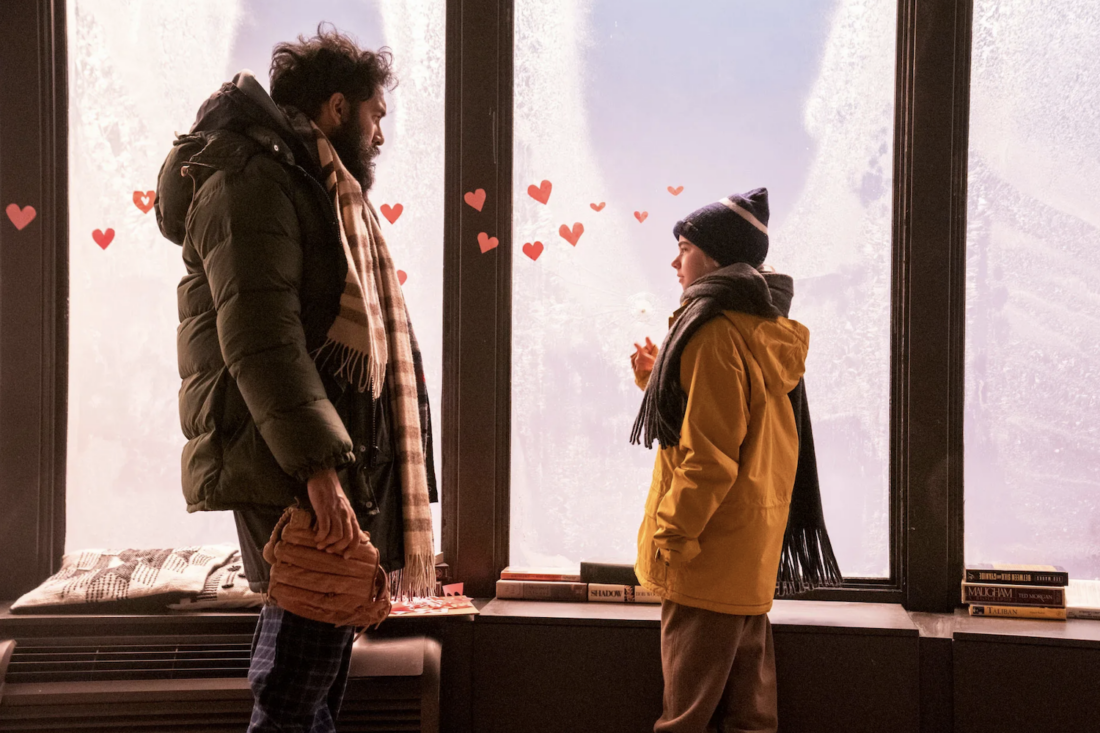
It’s been four years since COVID-19 first brought the world to a standstill, but more recently there has been increasing concern about the rise of a different type of pandemic. You may have heard about it, or read about it, in the last few years: the loneliness epidemic.
In New York just last year, nonagenarian sex therapist Dr. Ruth Westheimer declared that she wants to become New York’s “Loneliness Ambassador,” a position she’s invented in response to what she views as a crisis sweeping her state like a tidal wave. This came only a few months after the U.S. Surgeon General Dr. Vivek Murthy released a report calling loneliness and isolation in America a public health crisis. He “warn[ed] that isolation can be just as deadly as smoking up to 15 cigarettes a day and poses a greater risk to longevity than being sedentary or obese.” It’s simple, says Dr. Jeremy Nobel, founder of The Foundation for Art and Healing: “loneliness will kill you.”
What’s fascinating, and troubling, about these levels of loneliness and isolation is that they were rising even before COVID-19. There are of course many factors involved in large-scale, complex trends like these, but there’s one specific area I want to explore, one that the artifacts in Doerr and Mandel’s stories expose. It’s telling that the source of connection in both Doerr and Mandel’s stories is a form of media: a radio station and a book, respectively. In today’s world, we are treated as consumers of highly curated entertainment, and that feeds into this sense of loneliness and alienation. Though we may consume more and more avidly, our ability and need to communicate with others—to exchange thoughts and opinions, to share ideas—has been stunted, fractured. It can feel as if we are being kept apart by the things that—we feel—are supposed to bring us together. As if the technologies that were supposed to unite us have failed, and are actually doing the opposite.
The digital world promises greater connection, not just through proliferating ideas and information in the form of newspapers, magazines, chat rooms, and forums, but through art and entertainment. We now have increased access to more and more specific types of entertainment. We don’t have to depend on what the local channels are showing or what the people we share a living space with prefer to consume. We have our own devices with our own accounts that create our own feeds. The number of artistic offerings catering to niche interests multiplies by the day.
The second promise of technology is that even as we tailor our own individualized entertainment feed to our specific preferences, we can find communities who have similar tastes and preferences. Even if there’s nobody in my small town, or even my big city, who likes my favorite art movement or singer or fantasy novel, I can always find other people online who share my excitement and enthusiasm.
This is the alluring idea—that even as we create a more and more precise diet of entertainment, we will find fellow devotees who love the things we love. In fact, we can grow and expand our chosen communities and fandoms because we will be able to find people who better align with our tastes and preferences. But if this is true, then why are we still so lonely?
One can imagine an alternate ending to each of Doerr’s and Mandel’s stories that answers this question. Imagine the members of The Traveling Symphony flipping through Station Eleven, knowing that before the world turned upside down, someone else was able to make something beautiful that survived. Or picture Werner and Marie-Laure feeling a warm, fuzzy sensation of unity that disregards their actual physical locations, and the curtain falls upon them sitting alone in dark rooms with invisible gold strands of radio waves connecting them. There is a certain poignancy to that.
But that’s not how these stories end.
Climactic Encounters
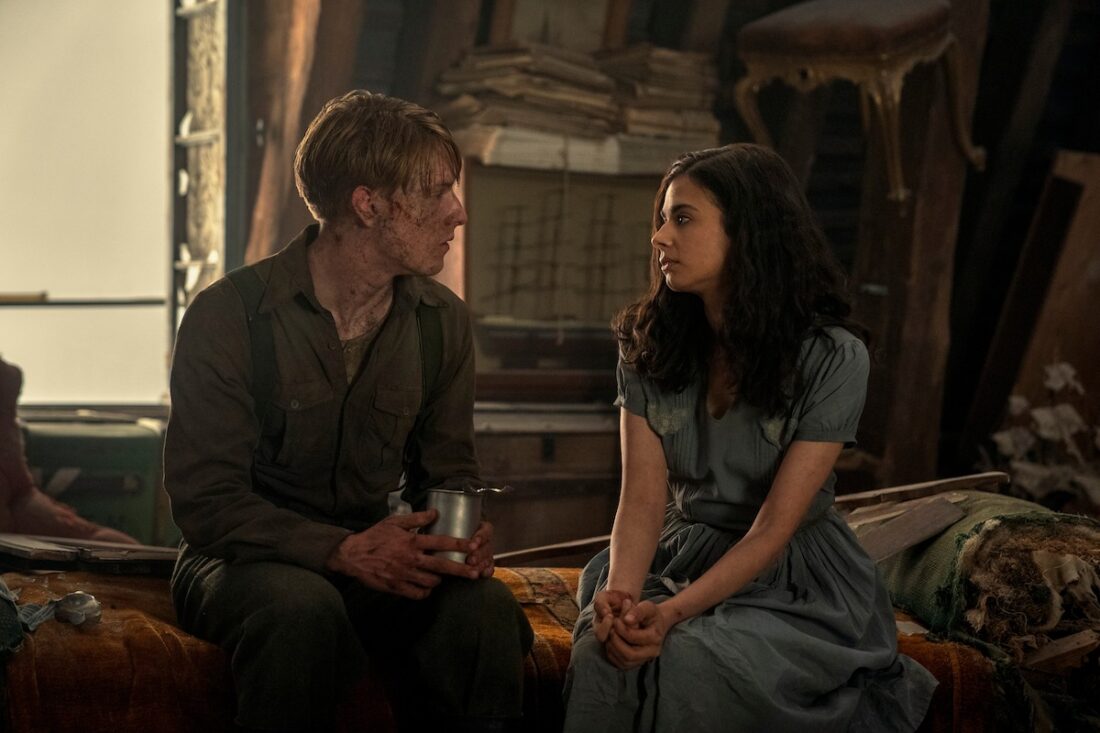
The culmination of each of these narratives is not that the characters find consolation in the same artifact while remaining siloed in their own separate realities. Rather, the emotional and narrative climax of these stories is the physical meeting between protagonists who first found each other remotely, mediated by the artifact. The high point we’ve been climbing toward is the movement of chatroom friendship to into physical proximity, with the separated friends finally meeting face to face and standing in the same room.
In the final chapters of All the Light, Doerr describes the moment Marie-Laure and Werner meet. He has just saved her life from a psychotic German soldier. He ascends the stairs to her attic hideout, where she has been listening to and broadcasting the radio station that has sustained them both since childhood. Doerr writes,
“Werner hears Marie-Laure inhale, Marie-Laure hears Werner scrape three fingernails across the wood, the sound not unlike the sound of a record coursing beneath the surface of a needle, their faces an arm’s reach apart.
“He says, ‘Es-tu là?’”
Are you here? Are you here, at last, in the same space as me?
It would never have been enough—for the characters, for the readers—for the story to end with Marie-Laure and Werner content with the radio’s cherished voice, separated still by miles and war and national boundaries. As a reader, you get to this scene and you hold your breath because this is what it has all been building toward. It’s only a couple of pages in the book, but those pages contain the catharsis the reader has been waiting for. (The TV adaptation rightly recognizes this point as the climax, expanding it into a more significant percentage of the runtime and adding in a kiss, as if the mere fact of them meeting for the first time isn’t powerful enough).
Mandel, too, builds her story around the physical meeting (in this case, a reunion) between her characters. The HBO Max adaptation of Station Eleven is a fan- and critic-pleaser and stays pretty faithful to the book. But the biggest change is the prominence of the relationship between two of the main characters, Kirsten and Jeevan. Thrown together through random events at the beginning of the deadly pandemic, the eight-year-old actress Kirsten and mid-thirties aspiring-EMT Jeevan survive the first few years together (a deviation from the mere months they spend together in the book—the show needs to give their relationship a stronger foundation).
In the cruel, alien, dog-eat-dog world where 99.99% of the population has died, the relationship frays until Kirsten runs away and a wounded Jeevan can’t follow. The impetus for this separation is the comic book, Kirsten’s one treasured copy of Station Eleven from before the pandemic. When she realizes she’s left it at one of their previous camps, she runs back to get it, despite the danger and Jeeven’s frustration at the lost time. His anger prevents him from pursuing her right away and once he does, he is wounded by a wolf, a daily threat in this dangerous new world. For the next twenty years, they each find their own way and new communities, but both remain haunted by the loss of their first and deepest post-pandemic bond.
Particularly in the show, the climax is less the fate of any individual character or the rising tide of hope for this brutal world as a whole but rather the reunion of these two people. In the finale, a now-grown Kirsten catches a girl stealing her copy of Station Eleven. She moves to chase the girl and reclaim the comic, just as she did 20 years ago, when she ran from Jeevan. But this time, she lets go of the precious comic book. She makes her peace with the fact that the reality of what she has is more important than what it symbolizes.
And it’s precisely because she does not chase down the little thief that she turns and bumps into Jeevan, whose path crosses hers once again (thanks to YouTuber @Rob954ever for that particular insight). Their eyes meet and they recognize each other. They walk slowly toward each other, reach out, hold each other tightly. The camera spins around them, lingering on their faces bared open with wonder and grief and love.
It’s a perfect, almost holy moment.
In our world, the hyper-curated consumption of art often separates us—more on that in a moment. In Doerr’s and Mandel’s worlds, particular pieces of art are the vehicles of reunification. Shortwave 13.10 and Station Eleven first connect our characters, even when they are physically separated. But when the crucial moment comes, they release the artifact and embrace what it was leading them to: each other. These climactic moments resonate with us because they heighten our ache. They reveal the depth of what we lack. They are powerful because they are relatively rare, in our experiences.
What’s Missing?
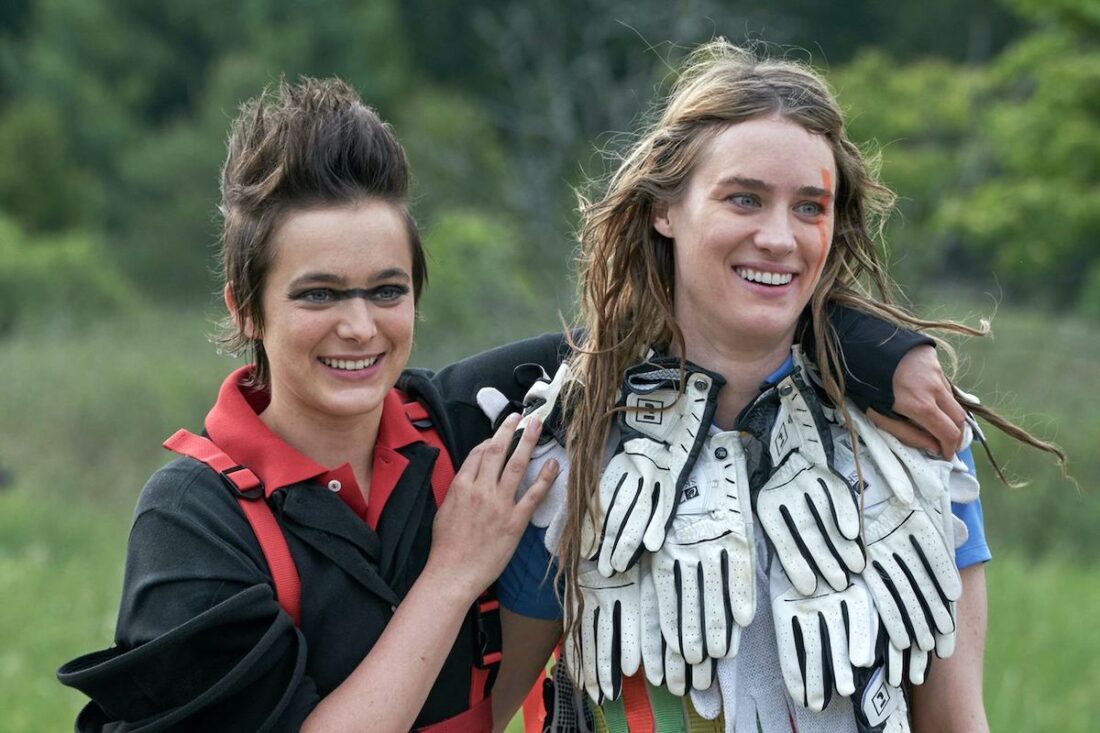
But wait: Is that true, that it is so rare for art to bring people together in the flesh? Let’s take a survey of entertainment habits today, looking at one of the most popular forms: TV shows.
Critics like to argue about the death of “appointment television,” and offer various explanations for when and how it died. While I missed out on most of the appointment TV era, I’m not entirely unfamiliar with the phenomenon; I too blocked off Tuesday nights last spring to watch the next Ted Lasso episode the minute it dropped. The difference between my Ted Lasso viewing and, say, the early ’90s Twin Peaks-era version of appointment TV is that if I absolutely had to miss the first airing (is that even the right term for streaming service releases?), I could watch it later at any other time, on a multitude of devices.
Or rather, that was one big difference. Another major difference between TV shows now and TV shows pre-21st century, give or take, is that Ted Lasso is one of 817,000 shows that are apparently available to me to watch (provided I have subscribed to every possible streaming service). Ted Lasso is one of the more popular series, out of these hundreds of thousands of shows; part of the joy of watching it is how many other people are talking about it (something I’ll return to in a moment). Even so, it is just one of many, many shows that I could have chosen to watch. That’s wholly unlike the television landscape when my parents grew up, when you had a bare minimum of channels to pick from—and probably only one that was geared to your particular demographic.
Last year, the BBC’s Louis Staples argued that the death knell had finally sounded for traditional soap operas. “Soaps losing viewers,” he argues, “particularly young people, reflects wider changes in our viewing habits.” It’s not just the logistical fact that streaming services are more popular and more convenient for most young people now, with accessible apps on their phones and available 24/7 after release. There’s also “a rise in ‘individual’ viewing too.” He quotes TV journalist Scott Bryan: “Ten years ago, it was much more likely that people would watch TV as a family. That is still true for some shows, but I think now we’re much more used to watching shows on individual screens…. This means that there is less of a tradition in terms of parents watching a soap with their kids and passing that on to them.”
Ed Finn, director of the Centre for Science and the Imagination at Arizona State University, proclaims the days of appointment TV over. In a 2020 article, he says: “We’re all watching asynchronously. We’re not really tuning in to the same broadcast, we’re watching things separated by hours or days—yet our communication about these shows is instantaneous. So the anxiety over spoilers, which seems to be bigger now than it’s ever been, is balanced by this driving need [for] a sense of community.”
The headline of the article Finn is quoted in says it all: “Suggestions, Subscriptions and No Sense of Community: Streaming is changing the way we watch TV.” No sense of community thanks to streaming—but why? Aren’t online worlds supposed to connect us in ways we never could when confined to the boundaries of our hometowns? Aren’t we able to find communities based on similar interests instead of physical proximity, and isn’t that supposed to open up whole new worlds and relationships that were previously inaccessible and unimaginable? Isn’t the freedom to choose what we consume supposed to make us, well, free?
Recently Melissa Kirsch wrote about “The Joy and Sorrow of Streaming” for The New York Times. When the buffet of available options left her feeling unsatisfied and far from sated, she articulates what this dissatisfaction led her to realize:
“I realized in the midst of my selective viewing that I wasn’t going to get what I wanted from the plot points of any particular movie I called up on a streaming service. What I wanted was a nostalgic, real-world experience: wandering in out of the cold of a midwinter’s afternoon, breathing in the stale popcorn-scented air of, say, the Angelika, or any of the city’s independent theaters, buying a ticket to whatever matinee is on, stumbling out afterward, changed. I didn’t want to watch a movie about people with interesting, complicated lives. I wanted to live my own.”
This, I think, is the best way to sum up the appeal that Doerr’s and Mandel’s stories hold for us. They tell us about worlds where the art and entertainment that speaks to us actually changes our lives in meaningful ways, where we are no longer simply consuming in a vaccuum but participating in communication and making a real connection
Most of us long for the kinds of connections that Doerr’s and Mandel’s characters experience. We are captivated by the idea that we could start out listening to a radio station on opposite sides of a war and, through that experience, eventually find ourselves eventually sitting side by side, at peace. Is it possible for us, too, to reach out and embrace another person the way Kirsten and Jeevan did, to have that moment where you see in the face of someone else all you have longed for, no longer separated or mediated by a screen, an avatar, an algorithm?
In spite of the loneliness epidemic, Doerr and Mandel hint that we could.
The Way Forward…
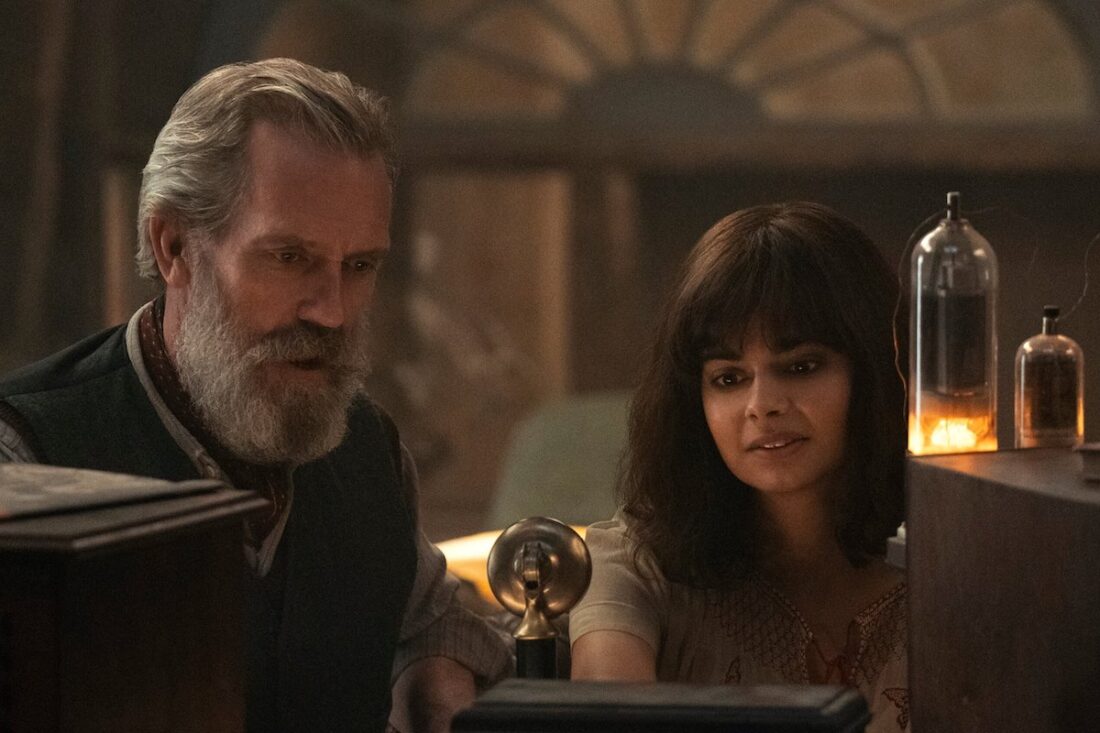
If we take a lesson from these stories, we might consider the following: Prioritize art experiences that involve physical community. Plan to enjoy at least some of your entertainment in physical proximity to others—whether loved ones or strangers. Choose to watch the less immediately interesting show if it means you can watch it with someone else. Not all the time but sometimes, intentionally sacrifice your top preference for the one that will bring you into contact with other people.
In short, rewind to the way we used to watch TV and movies, gathering together to share the experiences: Watch what your roommate watches. Or your dad, or spouse, or neighbor. Watch it together. Make time to talk about it in person.
The beauty of the online world is that it has brought together the like-minded from across the once-unbreakable boundaries of time and space. There’s real good in that, and I certainly don’t want to diminish its indisputable benefits. But as with any gain, there is a concomitant loss that we should not ignore. The ability to choose our communities based on interest versus geography has caused—or at least is correlated with—simultaneous separation from those whom we share physical space with, the people we share the most primal of human experiences with: sharing bathrooms, kitchens, beds; sharing the same air, the same plot of land (whether you own it or merely walk on it), the same smells and sights and sounds.
We’ve lost the casual, adventitious unity that came from all watching the same show because it’s the only thing on. Once, we sat in the same room with friends and family, watching shoulder-to-shoulder on the couch, and then discussed it with our neighbors or coworkers in the office the next day. What if, to combat this pandemic of loneliness, we again sought ways to experience art with those in our own neighborhoods, in our own homes, instead of solely digging deeper into our curated holes that only have room for our lonely selves?
The climactic scene where Kirsten and Jeevan reunite has been shared all over YouTube, and under one of those videos, @Rob954ever comments:
I cried like a baby. This show was one of the best things I have seen on t.v. EVER….So beautiful in that it’s not a typical dystopian/post apocalyptic story. How everyone was connected, by and to, the comic… How there was trust and a sense of community and not just violence in the world. That human kindness still existed was utterly amazing to watch. I loved the irony of this scene. Throughout the show, Kirsten kept telling herself and everyone around her that “that there is no before” because it hurt her so much to lose those she loved. And yet 20 years later, she finds Jeevan again. It started with them and it ended with them.
The comic book of Station Eleven unites various characters and is part of Kirsten and Jeevan’s initial bond. But notice that the titular work of art, the central piece of media, is nowhere in this comment. The main emotional thrust does not come from the work itself. It comes from the human connection it inspires.
We are moved by stories like Station Eleven and All the Light We Cannot See because they point to a world where our communication does not divide us but rather brings us together in profound ways. A world where the book we love—the show, the song, the painting, the game—is not a destination in itself, but rather the ticket to finding each other.










